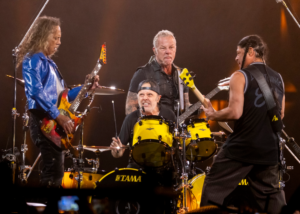Ask any seasoned drummer, and they’ll tell you: rhythm isn’t just a technical skill. It’s emotional. It’s personal. And at its best, it tells a story.
We don’t always think of drums as a storytelling instrument, especially in a world full of lyrics and melodies. But from the earliest human cultures to the most modern live performances, drums have played a deeper role than just keeping time. They’ve helped people share emotions, pass down history, and create meaning, beat by beat.
This isn’t some poetic exaggeration. It’s something we’ve seen across time, across continents, and musical genres. Drumming, when done with intention, speaks. And that language runs deeper than words.
How Drumming and Storytelling Are Naturally Linked
Let’s back up for a second. Before we had books or video or even a reliable way to write things down, people told stories with rhythm. Around campfires, in ceremonies, in rituals, drums were often at the center of it all. They set the tone. They pulled people in. They carried the emotion of the story being told.
Think about it: a slow, steady rhythm creates suspense. A sudden shift in tempo feels like a surprise twist. A repeating beat is like a recurring character or theme in a novel. It’s not just rhythm: it’s narrative.
And the reason this connection works is because rhythm hits us on a primal level. You don’t need a music degree to feel tension in a crescendo or recognise when a groove is telling you something is building. Our bodies respond to those cues without needing to think. It’s instinctual.
A Look at Drumming in Traditional Storytelling
This isn’t just theory, it’s backed up by culture and history. Take African talking drums, for example. These instruments mimic the pitch and tone of human speech. In some communities, people used them to send messages across distances. Skilled drummers could “speak” full sentences, announce events, or even tell local news, just using the drum.
In Native American cultures, drums are sacred. They’re not just instruments: they’re spiritual tools. In many tribes, the beat of the drum represents the heartbeat of the Earth. Stories told in ceremony are supported by drum rhythms that shift with the emotion of the tale—soft and reflective in one moment, intense and driving in the next.
Head to Japan, and you’ll see Taiko drumming. It’s bold, theatrical, and deeply expressive. Traditional Taiko performances aren’t just about sound, they include movement, costume, and group choreography. The story is told with every strike, every gesture.
And Celtic war drummers? They weren’t just setting a marching pace. Their patterns rallied troops, communicated formations, and reminded fighters of the legends they were defending.
Every one of these examples proves the same point: rhythm has always had the power to carry the story.
Telling a Story Through Modern Drumming
Even outside of traditional settings, drummers today are still telling stories. In fact, it’s part of what separates a technically good player from a truly great one.
1. Dynamics and Emotional Contrast
You can say a lot by changing how loud or soft you play. Start gentle and slowly build, suddenly you’ve created anticipation. Play loud, then drop out completely, and you’ve got suspense. A great drummer shapes the mood of a performance, not just its tempo.
2. Tempo Shifts and Dramatic Turns
One of the simplest ways to create drama is through speed. Pushing a beat just a little faster adds tension. Slowing things down right before a big chorus gives space. It’s a storytelling technique, plain and simple.
3. Repetition and Signature Grooves
Every great story has themes: ideas or feelings that come back again and again. Drummers do the same thing with grooves and fills. That one pattern you keep revisiting? That’s your story’s “hook.” It grounds the listener and helps them follow your journey.
4. Improvisation and Personality
Even in the most structured songs, there’s usually a moment for personal expression. Whether it’s a subtle fill or a full-blown solo, those moments are where the drummer’s personality shines through. No two players will approach them the same. That’s what makes it yours.
Where Drumming Meets Storytelling in Today’s Music World
Drums are everywhere now, in every kind of media, and they still tell stories in subtle but powerful ways.
In Film and TV Scores
Think of your favorite movie scene, the car chase, the cliffhanger, the emotional goodbye. Odds are, drums were there, building tension or driving the moment. Percussion is what gives those scenes their urgency. Without it, the emotion would fall flat.
In Concept Albums and Live Shows
Some bands use drums not just to hold things together, but to guide the story. Progressive rock, metal, and experimental genres often rely on shifting rhythms and percussive themes to move the narrative forward. In live shows, the drummer sets the energy level. They’re the unsung narrator of the concert.
In Theater and Performance Art
Live drumming is often used in movement pieces and experimental theater. The beat doesn’t follow the action, it creates it. Dancers and actors react to rhythm in real time. It’s a conversation without words.
Looking Ahead: The Future of Storytelling Through Drums
As music tech keeps evolving, so does the way drummers express themselves. These days, the toolbox is bigger than ever.
Electronic Kits and Digital Pads
With the push of a stick, drummers can now trigger any sound—rainfall, birdsong, spoken word samples. That makes it easier to weave literal storytelling elements into rhythmic performance. Some artists are even syncing visuals with their playing to build immersive, multi-sensory experiences.
Hybrid Setups
It’s not just acoustic anymore. Drummers are blending traditional kits with sample pads, triggers, and looping stations to create textured soundscapes. This allows them to tell layered stories: emotional, abstract, and cinematic.
AI and Algorithmic Rhythm
A few artists are experimenting with algorithm-based drumming. AI can generate unexpected patterns or grooves, even linking up through digital programs in Pro Tools and Ableton, helping musicians step outside their own habits and explore new narrative rhythms. It’s still early days, but it shows how storytelling in music is always evolving.



